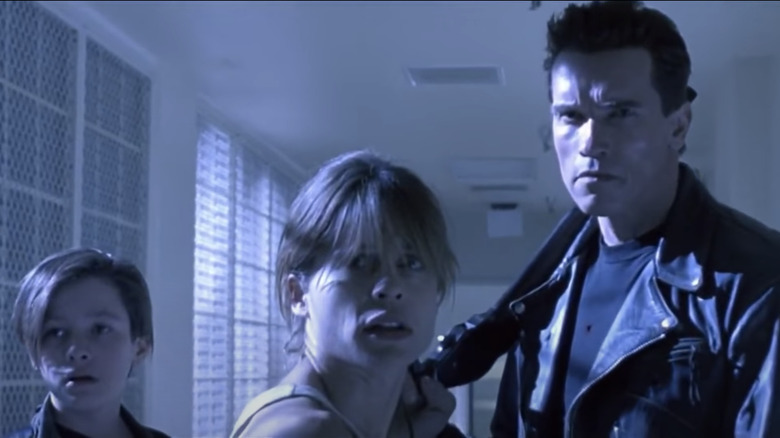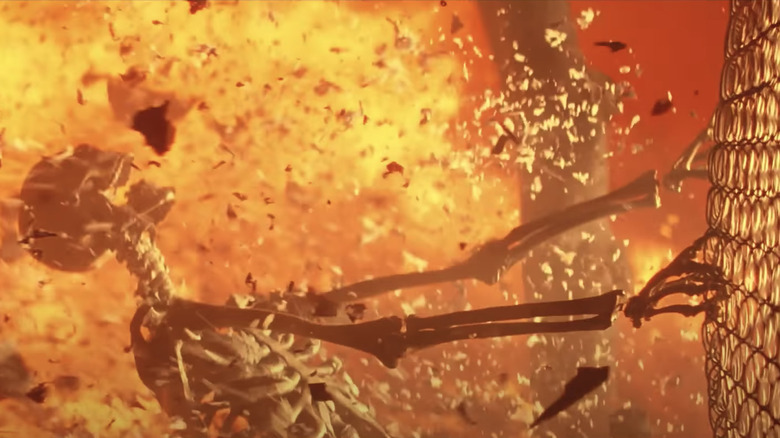The Terminator 2 Alternate Ending That Would've Killed The Franchise
There's no denying that "Terminator 2: Judgment Day" is the best film in the entire franchise. Essentially inverting the character dynamics of the first film while continuing to flesh out details of the impending android apocalypse, "T2" might even hold water as one of the greatest sequels ever made. However, director James Cameron almost presented a very different film to 1991 audiences. Though it was ultimately left on the cutting room floor, the ending was at one point set on a saccharine note that would have effectively ended the potential for future installments of the "Terminator" franchise.
Below, we'll dig into the film itself, its theatrical ending, and the alternate ending that would have neatly wrapped everything up.
A Brief Breakdown of Terminator 2
For those out of the loop, the affectionately-dubbed "T2" revolves around Sarah Connor (Linda Hamilton), who is committed to a psych ward due to her violent insistence that nuclear apocalypse will occur on August 29, 1997. Her 10-year-old son John (Edward Furlong) is now the target of artificial intelligence entity Skynet, which sends a new T-1000 Terminator back in time to assassinate the future leader of the human resistance against the machines. Meanwhile, future John sends a reprogrammed Model 101 terminator (Arnold Schwarzenegger) back to protect his younger self and mother from the highly advanced T-1000. The task of preventing the apocalypse — which is presented as a hellish, instantly-incinerating firestorm in one of the film's most iconic scenes — falls squarely on the shoulders of Sarah, John, and the Terminator. The film dares to ask: Is fate something that can truly be controlled?
The Actual Ending
After about 135 minutes of pyrotechnic glory, Sarah, John, and the Terminator successfully defeat the T-1000 by submerging it in an industrial vat of molten steel after they battle in a processing plant. Though they're overjoyed that the future-dwelling assassin is no longer threatening their lives, a somber realization falls upon the trio: In order to fully prevent Skynet from ever rising to power, the Model 101 must also be destroyed. Despite John's sobbing pleas (it turns out the Terminator has been more of a friend than the boy has ever known), Sarah obliges the Terminator's request to condemn him to the scorching pit of liquid steel. In one of the most heartbreaking scenes to ever grace the screen, the Terminator bids John goodbye by way of an earnest thumbs up before his processing system is rendered to mush.
As Sarah cradles John in her arms — perhaps one of the singular instances of the hardened woman comforting her young son — the film cuts away to a shot of a slick black road, completely desolate save for the glare of headlights illuminating the steadily passing pavement.
"The unknown future rolls toward us," says Sarah via voice-over, presumably driving the car speeding down the vacant highway. "I face it for the first time with a sense of hope. Because if a machine, a Terminator, can learn the value of a human life ... maybe we can, too."
Though the ending certainly communicates Sarah's newfound streak of cautious optimism, it also leaves room for this illusion to be shattered. In the franchise's subsequent installments — including "Terminator: Dark Fate," which is essentially a direct sequel to "T2" — it's clear that humanity is never really saved, and that a constant battle between human and machine ensues between timelines.
The Alternate Ending
Though it's been an overwhelmingly successful franchise, James Cameron nearly wrapped the entire storyline of the "Terminator" films with a neat little bow in an alternate ending for "T2." The alternate ending reveals Sarah as an old woman, watching lovingly as a grown-up John pushes his young daughter on the swings at a playground (one that, thankfully, doesn't disintegrate into smoldering ash). She reminisces on her bygone fear of human annihilation, a threat which passed 30 years ago without incident.
"August 29, 1997 came and went," muses Sarah. "Nothing much happened. Michael Jackson turned 40. There was no Judgement Day."
With the dread of nuclear holocaust no longer arresting her, Sarah has aged into a doting grandmother — one who affectionately ties her granddaughter's shoe before she runs off to continue playing. With this conclusion, however, the potential for the story to be expanded upon is utterly capped. How can the machines cause an uprising when Sarah has lived past the potential for their rule? There's always the possibility of future films presenting an alternate timeline or asserting that this conclusion was merely a dream sequence (much like the earlier scene of Sarah looking in abject horror as children are engulfed in flame), but these explanations would translate as cheap.
However, the cut scene's final lines of dialogue remain virtually unchanged in the released theatrical version. "The luxury of hope was given to me by the Terminator," she begins. "Because if a machine can learn the value of a human life...maybe we can, too"
Realistically speaking, the alternate ending was simply too hopeful (and not franchise-forward enough) to make it to "T2"'s final cut. While it adds some interesting character details — John becomes a senator, Sarah becomes a matriarch — the alternate ending does feel somewhat sanitized compared to the film's throughline of embittered nihilism. The theatrical ending, on the other hand, matches the tone previously established by Cameron. The oil-slicked street is perhaps the road forward, but it could just as easily be an ominous path to inevitable human downfall.

